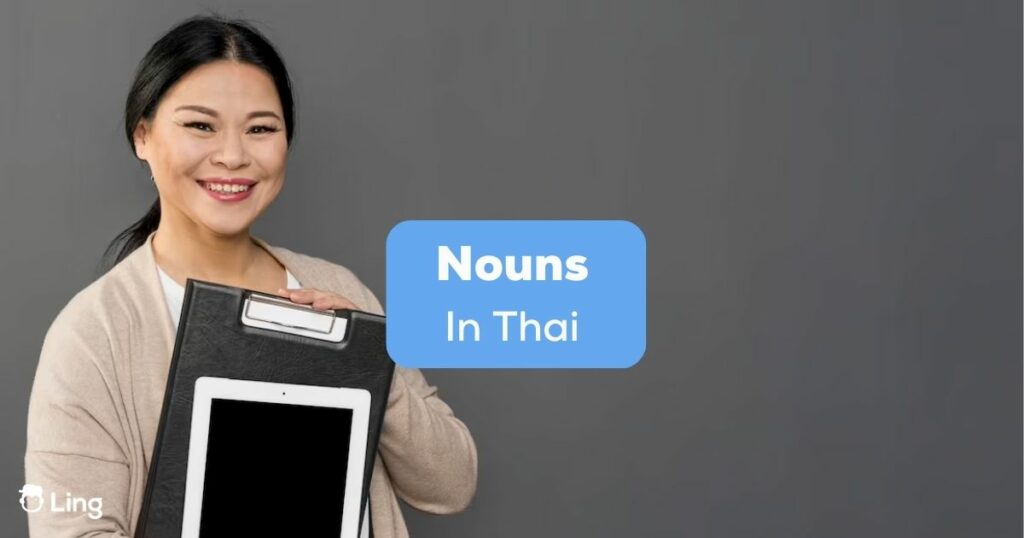Ever tried to assemble a puzzle without knowing what the finished picture should look like? You’d probably feel a bit lost, right?
That’s how diving into a new language can feel at first – like a jigsaw puzzle with scattered pieces. So, what’s the key to making sense of it all? One word: nouns.
Imagine you’re in Bangkok, the bustling capital of Thailand. You’re trying to buy a book – or in Thai, a “หนังสือ” (nung-seu).
Suddenly, you realize that understanding this simple noun can be a game-changer.
It’s not just a word. It’s a tool for communication, a bridge to understanding, and a stepping stone to becoming fluent in Thai.
Today, we’ll discuss nouns in Thai, breaking them down into digestible, easy-to-understand pieces.
From the basics to more complex concepts, we’ve got you covered. Let’s get your Thai language learning into high gear!
Basics Of Thai Nouns
Let’s start with the basics. Thai nouns are the building blocks that give meaning and context to your sentences.
Without them, your Thai conversations would be like a film without a script. So, where do we begin?
Characteristics Of Thai Nouns
Thai nouns, like English ones, can represent a person, place, thing, or idea. But that’s where the similarity ends.
See, nouns in Thai come with their own set of rules.
They don’t have gender, making it easier for learners who’ve wrestled with ‘der, die, das’ in German or ‘le, la’ in French. That’s one less headache, right?
But here’s another spin.
Thai nouns don’t change form. There’s no adding ‘s’ or ‘es’ to pluralize or ‘-ing’ to verbalize.
They remain the same whether you’re talking about one cat or ten, whether your cat is sleeping or jumping.
So, you can say Thai nouns are a bit like chameleons – they adapt to their sentence environment without changing their form.
Examples Of Common Thai Nouns
- คน (khon) – person. Use it when you’re talking about someone. For example, “คนนี้คือใคร?” (khon nee kue krai?) – “Who is this person?”
- หมา (maa) – dog. Use it when your new Thai friend shows you a photo of their pet. You could say, “หมาน่ารัก” (maa na-rak) – “The dog is cute.”
- รถ (rot) – car. Let’s say you want to tell your Thai colleague you’re leaving. You could say, “ฉันขับรถกลับบ้าน” (chan kap rot glap baan) – “I drive a car home.”
- อาหาร (a-haan) – food. Visiting a Thai market? You might ask, “อาหารไทยที่นี่อร่อยหรือเปล่า” (a-haan Thai thee nee a-roi mai?) – “Is the Thai food here delicious?”
- โรงเรียน (roong-rien) – school. If you’re asking about someone’s school, you could say, “โรงเรียนของคุณอยู่ที่ไหน” (roong-rien khong khun yu thee nai?) – “Where is your school?”
The Simplicity Of Singular And Plural Nouns In The Thai Language
Now, what about singular and plural nouns? Are they like stepping on a linguistic landmine? Not in Thai.
Remember our chameleon analogy? Thai nouns don’t change, whether they’re singular or plural.
If you’re talking about one book or ten books, you’d still use “หนังสือ” (nung-seu).
So how do you know if it’s one book or ten? It’s all about context and counting words.
In Thai, you’d use a numeral followed by a classifier to express a quantity.
What’s a classifier? Think of it as a tag that goes with the noun.
For example, for books, the classifier is “เล่ม” (lem). So, if you’re borrowing three books, you’d say “หนังสือสามเล่ม” (nung-seu saam lem), literally “book three volumes.”
See, Thai makes the quantity game quite straightforward, doesn’t it?

Classifiers, Quantity, And Possessive Thai Nouns
Let’s add some flair to your Thai noun dance. Yep, Classifiers, quantity, and possessive nouns.
Feeling a bit daunted? No worries. We’re taking this step by step.
The Role Of Classifiers
Classifiers are specific words used in Thai to indicate the type or category of a noun.
In English, we say “a piece of cake” or “a cup of coffee,” right? Thai classifiers work a bit like that, but they’re used much more frequently.
They come into play when dealing with numbers, some pronouns, and adjectives.
Instead of saying “three dogs” in Thai, you would say “dog three animal” or “หมาสามตัว” (maa saam tua).
Notice how “ตัว” (tua), the animal classifier, comes after the numeral? That’s the Thai way.
How Quantity Is Expressed In Thai
Expressing quantity in Thai is like serving up a tasty meal. You need the right ingredients in the right order.
Start with your noun, add your numeral, and finish with your classifier. Voila! A perfectly constructed Thai quantity.
Let’s use “cats” as an example.
One cat in Thai would be “แมวหนึ่งตัว” (maew neung tua).
Here “แมว” (maew) is the noun cat, “หนึ่ง” (neung) is the numeral one, and “ตัว” (tua) is the classifier for small animals.
So, three cats would be “แมวสามตัว” (maew saam tua). Easy, right?
Possessive Nouns: The Thai Way
Now, let’s talk about ownership. Not in a business sense, mind you. We’re talking about possessive nouns in Thai.
Unlike English, Thai doesn’t use an apostrophe to show possession.
Instead, they employ the word “ของ” (kong), which translates as “of” or “belonging to.”
Think of “ของ” (kong) as the link that ties the owner to the object.
So, if you’re translating “Mary’s cat” into Thai, you’d say “แมวของแมรี่” (maew kong Mary).
Here “แมว” (maew) is the cat, “ของ” (kong) is the possessive link, and “แมรี่” (Mary) is our cat owner.

Thai Compound Nouns
Now that we’ve got classifiers, quantity, and possessive nouns down, let’s shake things up a bit. Let’s tackle Thai compound nouns.
Concept Of Thai Compound Nouns
Compound nouns might sound like a high school chemistry experiment, but they’re pretty straightforward.
They’re just nouns made up of two or more words that function as a single unit of meaning.
In Thai grammar, the word order in compound nouns often flips, compared to English.
The main noun often comes first, followed by the word that describes it.
Take the example of a “mobile phone” or “cell phone” in Thai, which is “โทรศัพท์มือถือ” (tho-rasap mue-thue).
Here, “โทรศัพท์” (tho-rasap) means “phone,” and “มือถือ” (mue-thue) means “mobile” or “handheld.”
Notice how the main noun “phone” comes first, followed by the descriptive word “mobile/handheld.”
Examples And Usage Of Thai Compound Nouns
- อาหารเช้า (a-haan chao) – breakfast. “อาหาร” (a-haan) means food, and “เช้า” (chao) means morning. Combine them, and you’ve got the day’s most important meal!
- กระดาษทราย (gra-daat saai) – sandpaper. Here, “กระดาษ” (gra-daat) means paper, and “ทราย” (saai) is sand. Put them together, and you get a useful tool for any DIY project.
- คอมพิวเตอร์โน๊ตบุ๊ค (khom-piut-ter note-buk) – laptop computer. “คอมพิวเตอร์” (khom-piut-ter) is a computer, and “โน๊ตบุ๊ค” (note-buk) is the notebook, giving you the Thai term for your portable PC.
- แว่นตา (waen-taa) – glasses. “แว่น” (waen) refers to a lens or glass, and “ตา” (taa) means eye. Combine the two, and you’ve got the Thai word for those handy tools that help you see clearly.
- บัตรเครดิต (bat-kha-redit) – credit card. “บัตร” (bat) is the card, and “เครดิต” (kha-redit) is credit. Put them together, and you have a key component of modern finance.
Noun Reduplication: Expressing Plurality And Diversity
Are you ready to spice up your Thai vocabulary with some duplication?
In Thai, they often repeat nouns, not for redundancy, but to convey the idea of plurality or diversity.
Let’s take “เด็ก” (dek), which means “child.”
To express “children” or to emphasize a group, they double it up: “เด็ก ๆ” (dek dek). It’s like saying, “Children, and lots of them!”
This isn’t just about quantity. It’s also about variety.
If you’re talking about “food” or “อาหาร” (a-haan), and you want to express the idea of all kinds of food, you say “อาหาร ๆ” (a-haan a-haan). Isn’t that neat?

Honorific Nouns: A Unique Aspect Of Thai Culture
Here’s something special about the Thai language: Thai honorifics.
They’re more than just fancy titles – they’re a nod to the respect and societal hierarchy ingrained in Thai culture.
Consider “คุณ” (khun), a term they use before names.
It’s not just a stand-in for “Mr.” or “Ms.” It’s a way of saying, “I see you, and I respect you.”
Then they have “ท่าน” (than), used for someone of higher status or age.
It’s a bit like “sir” or “madam” but with a Thai twist.
Thai people use it in more formal or professional settings, adding an extra layer of respect to their conversations.
Forming Basic Thai Sentences With Nouns
Thai sentence structure often follows the Subject-Verb-Object (SVO) order, similar to English.
For instance, if we take “หมา” (maa), which means “dog,” and “วิ่ง” (wing), which means “run,” we can create a simple sentence: “หมาวิ่ง” (maa wing) or “The dog runs.” Pretty simple, right?
However, one exciting thing about Thai is that sometimes, the subject can be implied and not explicitly stated.
So, if the context is clear, you might hear just “วิ่ง” (wing) with the “หมา” (maa) being understood.
Advanced Thai Sentence Construction: More Than Just Nouns
Moving into the final lesson on more complex sentence structures, we need more than just nouns.
We start to see the importance of particles, classifiers, and even the position of words in a sentence.
For instance, let’s take the sentence, “I read that book.”
In Thai, it would be “ฉันอ่านหนังสือเล่มนั้น” (Chan aan nang-seu lem nan). Notice how the word “เล่ม” (lem), a classifier, is used with the book (noun).
By understanding these intricate aspects of Thai sentence construction, you’ll unlock the ability to express yourself more precisely and fluently.
Learn Nouns In Thai With Ling!
We’ve had quite the tour of nouns in Thai, haven’t we? But remember, learning doesn’t end here.
It’s time to pack this knowledge and step into the real language playground.
The best way to do that is with the Ling app! It’s more than an app. It’s your partner in language learning.
With lessons for over 60 languages, you can dive into practical exercises and explore new languages!
So, why sit on the sidelines? Jump into the language arena with Ling.
Start practicing, start learning, and start speaking. Thai nouns are just the beginning.
Get it from Google Play and App Store today!


































































